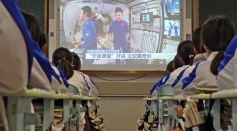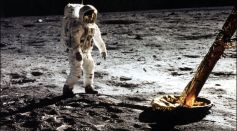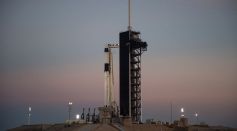Tags: Space

How Old Is Earth? Meteorite Suggests Water Exists In Solar System Even Before The Planet Itself

Environmental Cost of Astronomy Needs to Be Reduced, Will the World's Most Sustainable Observatory Solve It?

Hopewell Culture May Have Been Ruined by Comet Explosion 1,500 Years Ago

Controlling Robots From Space

Tiangong Space Station Adorned in Red for Taikonauts' First Lunar New Year Celebration

Israel Joins NASA Artemis Program to Bring Astronauts to Moon

Pilot Missed Chance To Be Part of SpaceX Inspiration4 Crew After Winning Raffle Due To His Weight

Planet Search Is Not Easy! Astronomers Tell Us How They Discovered Almost 5,000 New Exoplanets

Milky Way Now Has Thousands Of Stunning Magnetic Threads Like A 'Modern Art', Scientists Say

SpaceX Wants to Launch Rockets Weekly to Achieve Elon Musk's Goal of Having 52 Missions in 2022

Spooky Cosmic Object Could Be A New Type of Star With Ultra-Powerful Magnetic Field

Human Economy Worth $1 Trillion To Move To Space By 2040? Here's What Data Shows

Falcon 9 Rocket's Second Stage Will Likely Impact Moon's Equator After 7 Years of Floating Through Space

Space Fitness: ISS Inhabitant Matthias Maurer Posts Video Showing Him Doing Some Exercise Beyond Walking

Young Stellar Jets Wandering Through Field of Stars Captured in New Images Using Gemini South Telescope

Star Fuel Reservoirs That Surround Galaxies, Enable Formation of New Planets

NASA Offers Challenge and Reward In Finding Solution For Waste, Trash Sustainable Reprocessing In Mars and Other Space Missions; How to Join

555.55-Carat Black Diamond Sotheby’s Gem Believed To Be From Outer Space Unveiled

JAXA Develops Culture Bag for Crop Production and Long-Term Food Supply in Space

Space Adventure, the Largest Space Exhibit Ever Seen, Kicks-off Its North American Tour in Miami, FL This April
Most Popular

Orionids Meteor Shower Happening Next Week: Where and When To Catch the October Light Show's Peak

Texas Official Shot Down Siren Flood Alert, Complaining That It Might Go Off 'In the Middle of the Night': Report

Nvidia's Jetson Thor Could Make Humanoids Smarter Than Ever

Hellfire Missile Video Reveals MQ-9 Reapers Being Used for Aerial Combat





